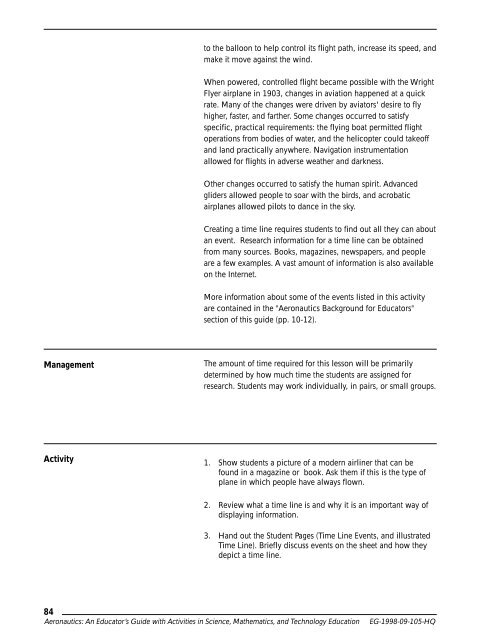Aeronautics Educators' Guide - ER - NASA
Aeronautics Educators' Guide - ER - NASA
Aeronautics Educators' Guide - ER - NASA
Create successful ePaper yourself
Turn your PDF publications into a flip-book with our unique Google optimized e-Paper software.
to the balloon to help control its flight path, increase its speed, and<br />
make it move against the wind.<br />
When powered, controlled flight became possible with the Wright<br />
Flyer airplane in 1903, changes in aviation happened at a quick<br />
rate. Many of the changes were driven by aviators' desire to fly<br />
higher, faster, and farther. Some changes occurred to satisfy<br />
specific, practical requirements: the flying boat permitted flight<br />
operations from bodies of water, and the helicopter could takeoff<br />
and land practically anywhere. Navigation instrumentation<br />
allowed for flights in adverse weather and darkness.<br />
Other changes occurred to satisfy the human spirit. Advanced<br />
gliders allowed people to soar with the birds, and acrobatic<br />
airplanes allowed pilots to dance in the sky.<br />
Creating a time line requires students to find out all they can about<br />
an event. Research information for a time line can be obtained<br />
from many sources. Books, magazines, newspapers, and people<br />
are a few examples. A vast amount of information is also available<br />
on the Internet.<br />
More information about some of the events listed in this activity<br />
are contained in the "<strong>Aeronautics</strong> Background for Educators"<br />
section of this guide (pp. 10-12).<br />
Management<br />
The amount of time required for this lesson will be primarily<br />
determined by how much time the students are assigned for<br />
research. Students may work individually, in pairs, or small groups.<br />
Activity 1. Show students a picture of a modern airliner that can be<br />
found in a magazine or book. Ask them if this is the type of<br />
plane in which people have always flown.<br />
2. Review what a time line is and why it is an important way of<br />
displaying information.<br />
3. Hand out the Student Pages (Time Line Events, and illustrated<br />
Time Line). Briefly discuss events on the sheet and how they<br />
depict a time line.<br />
84<br />
<strong>Aeronautics</strong>: An Educator’s <strong>Guide</strong> with Activities in Science, Mathematics, and Technology Education<br />
EG-1998-09-105-HQ

















